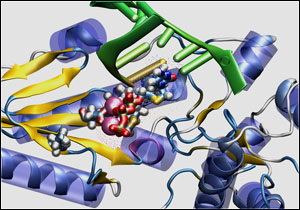
Lamivudine complexes with nucleic acids (green) in HBV
polymerase, highlighting residues related to drug resistance
Multi-Drug Resistance
- Multi-drug resistant HBV has been reported in hepatitis B patients who have received sequential antiviral therapy. In vitro studies have shown that HBV constructs with mutations resistant to lamivudine and adefovir have marked reduction in sensitivity to the combination of lamivudine and adefovir, whereas constructs with mutations resistant to either drug remain sensitive to the other drug
- Mutations conferring resistance to multiple antiviral agents have been shown to co-locate on the same viral genome, suggesting that combination therapy directed against mutations resistant to each treatment may not be adequate in suppressing multi-drug resistant HBV
- Successive evolution of different patterns of resistant mutations has been reported during long-term lamivudine therapy. The initial mutations are usually associated with decreased replication fitness compared with wild-type HBV; however, additional mutations that can restore replication fitness are frequently selected as treatment is continued. These are the secondary or compensatory mutations that then affect future rescue therapy with the next line of antiviral agents
- Successive evolution of mutations may result in a combination of mutations that have the greatest replication fitness as well as maximum drug resistance in patients with multi-drug resistant HBV
All material copyright Evivar Medical Pty. Ltd. All rights reserved